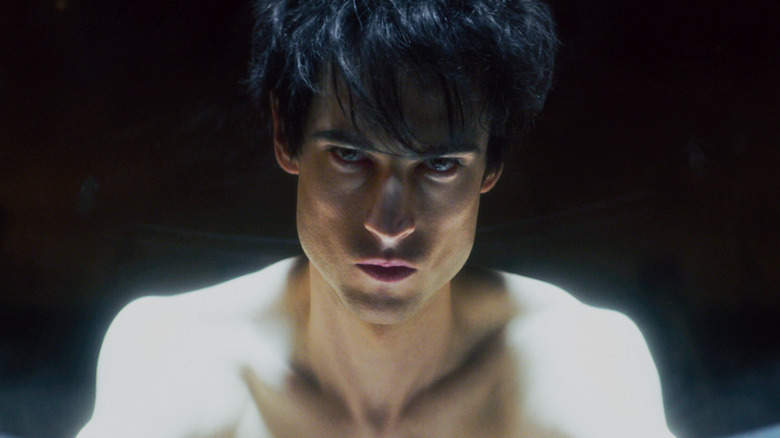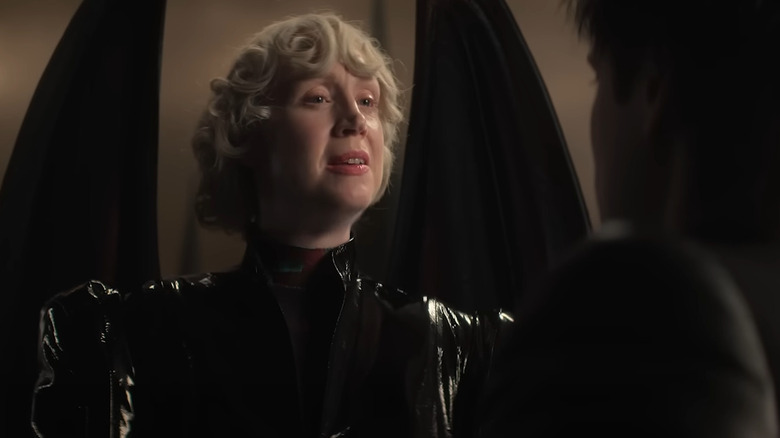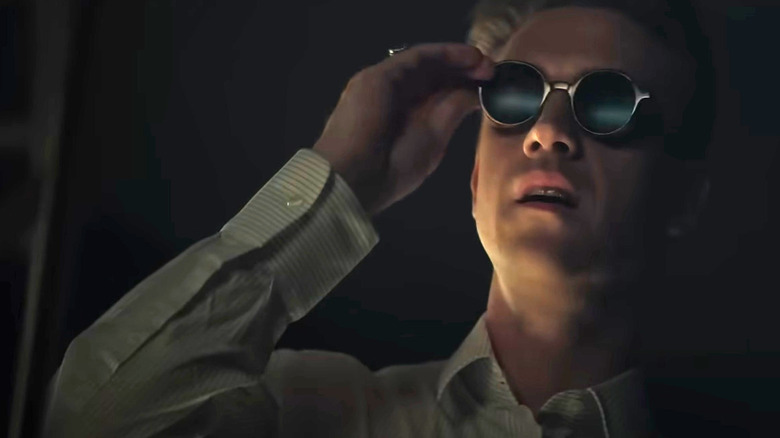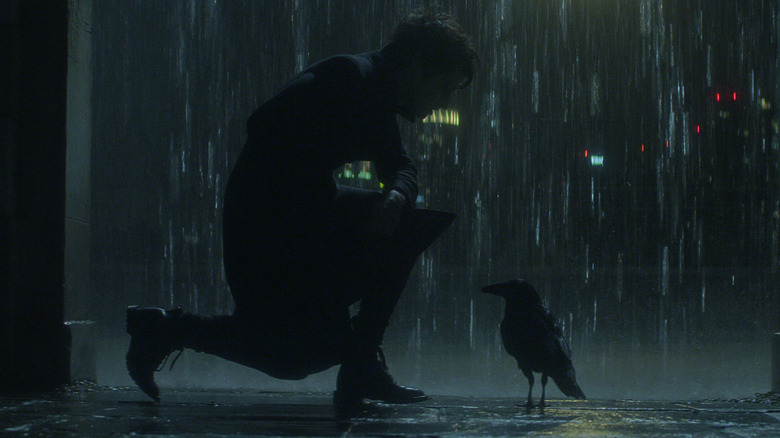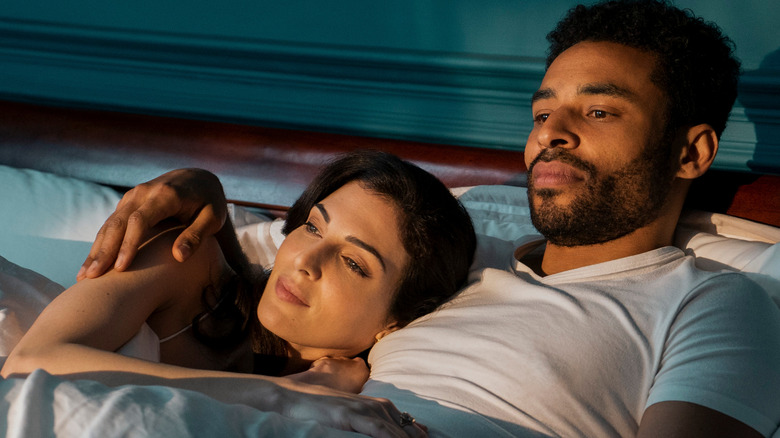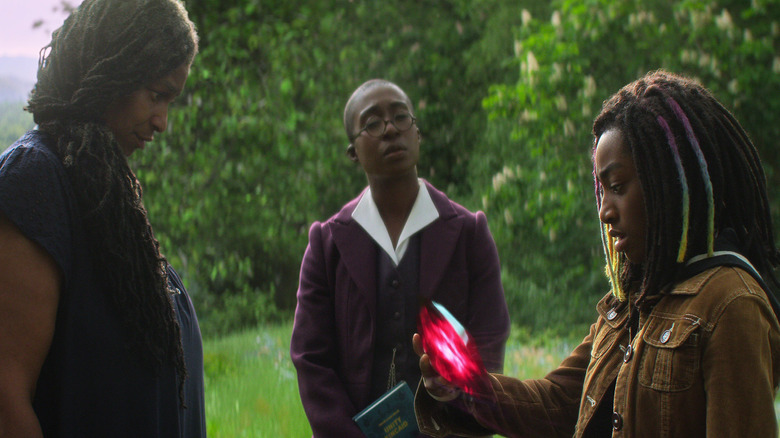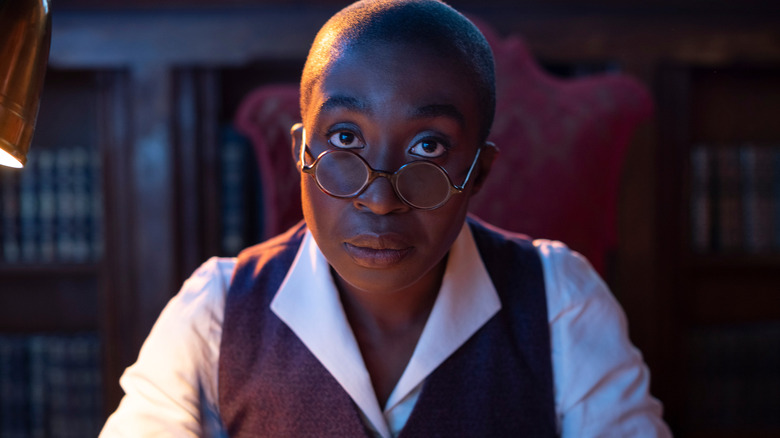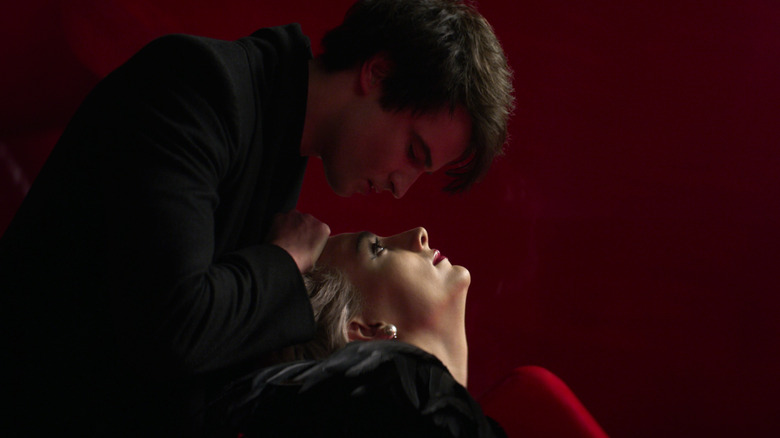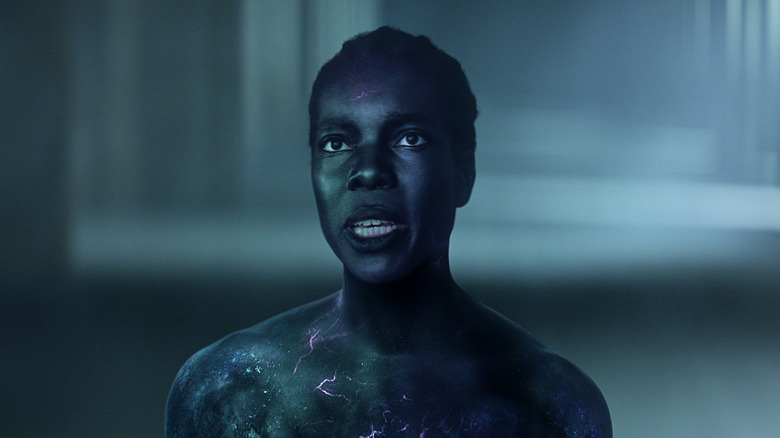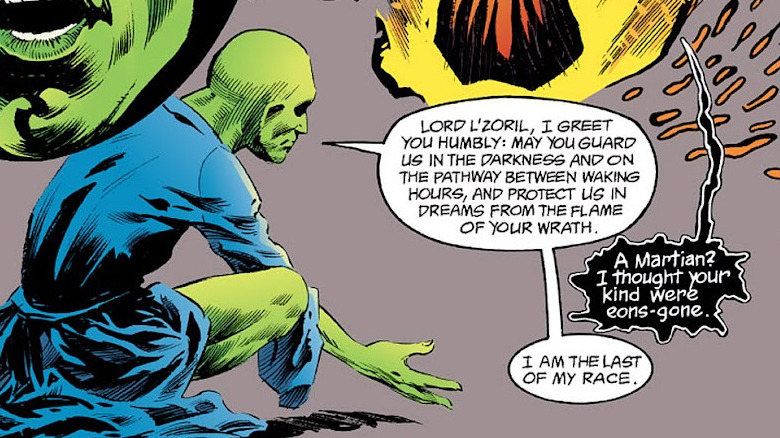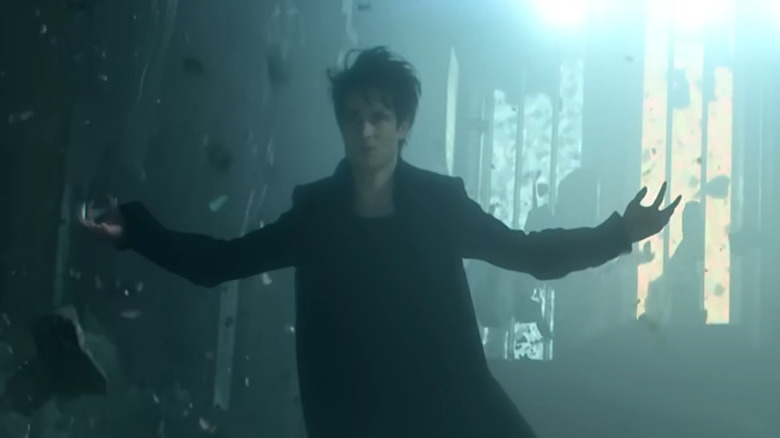The Ending Of The Sandman Season 1 Explained
The road to a live-action adaptation of Neil Gaiman's critically acclaimed Vertigo series "The Sandman" panned the course of nearly three decades (via Inquisitr). A major milestone came in 2019 when, after years of stop-and-go development, the journey from printed page to screen for Morpheus aka Dream of the Endless (played by Tom Sturridge) found him a new home in Netflix (per The Hollywood Reporter). Initially announced as an 11-episode series, the show's first season has finally debuted on the streaming platform.
Drawing inspiration from the first 16 issues of the comics series, Netflix's "The Sandman" is a mostly faithful reinterpretation of the "Preludes and Nocturnes" and "The Doll's House" storylines, with a few modifications — some minor, some major — likely implemented in the interest of telling a tighter, more focused story over a 10-episode span. A review published by The Guardian even calls the show "2022's single greatest hour of TV drama," praising its engrossing story and an emotional depth that add further substance to what might have otherwise been just a violent CGI fantasy spectacle.
Fortunately, one need not be familiar with the source material to follow the live-action adventures of the Lord of Dreams and appreciate the rich mythos of "The Sandman." With a compelling narrative and well-developed characters, the season concludes satisfactorily, bringing important story arcs to a close while dangling enough threads to tease whatever might come next. Here's the ending of "The Sandman" Season 1 explained, including why certain changes were made and whether a second season is already in development. (Spoilers follow.)
Lucifer prepares to take down Morpheus
The final episode of "The Sandman" Season 1 shows the demonic generals of Hell egging Lucifer Morningstar (Gwendoline Christie) on, with the hellish ruler plotting to use the full might of their armies to bring Morpheus to his knees. While this strongly hints at a full-blown war between the demons of Hell and the forces of the Dreaming, if the show follows the course of the source material, this subplot will likely end in Lucifer's retirement from being the monarch of Hell — perhaps even following a similar path to that of the Lucifer that Tom Ellis portrayed in the eponymous series (which was also based on the version of the character in "The Sandman").
Then again, the showrunners may subvert the expectations of longtime fans, and things could unfold on the TV show in an entirely different manner. In an interview with TV Line, Christie mused that the idea of losing to Dream must be "entirely consuming" for the former favored angel of God — perhaps enough for it to dwell on their mind and dictate their actions in future seasons — and could even be considered the "final insult" for them. Additionally, Christie revealed (via Digital Spy) that her portrayal of Lucifer wasn't even inspired by Tom Ellis' version to begin with, despite being a fan of the latter. She even avoided watching Ellis' show so that it wouldn't influence her take on the role, and instead opted to take inspiration from assorted material.
The Corinthian meets his end
Introduced as early as Episode 1, the Corinthian (Boyd Holbrook) serves as the primary antagonist for most of the first season of Netflix's "The Sandman." The Corinthian's apparent obsession with killing people in the Waking World — and the unmistakable joy he derives from taking a life — makes him the ideal season-long foil for Morpheus.
Aside from being an incredibly dangerous opponent, the Corinthian also represents everything that stands against Dream's principles. While Morpheus is all about maintaining balance, adhering to predetermined roles, and restoring things to the way they were before his disappearance, the Corinthian delights in becoming an agent of chaos and murder on Earth, and starkly refuses to stick to the responsibilities he was created to fulfill. In "The Sandman Companion" (as cited by the Mary Sue), Gaiman confirmed that the nightmare's name came from the word pertaining to the behavior typically attributed to someone from the ancient Grecian region of Corinth: reckless, lacking in morals, and possessing a distaste for rules.
Given how closely the series sticks to the events of the source material, it's highly likely that we'll see the Corinthian again in a future season, though perhaps not anytime soon. Despite Dream's proclamation at the end of Episode 10 that the world doesn't need another mouth-eyed nightmare just yet, the comic book version of the Lord of Dreams does end up remaking a more loyal, less petty version of the Corinthian.
The Lord of Dreams mellows
The beginning of Netflix's "Sandman" series shows how Dream was captured by Roderick Burgess (Charles Dance) in 1916 and kept as a prisoner in his mansion in Wych Cross, England. The ruler of the Dreaming is shown to be unwavering, ruthless, and inflexible in his purpose as well as his resolve. He spends decades in his prison, remaining completely silent while being guarded round the clock by Burgess' men. And when an opportunity to escape arises, Morpheus swiftly takes it.
However, his quest to bring things back to the way they were leads him to become gradually but profoundly changed. He begins to realize that he has committed mistakes during the course of his rule as dreamlord, and also learns to be less rigid and more merciful. He recognizes the efforts of his librarian Lucienne (Vivienne Acheampong) to keep the Dreaming running in his extended absence. He also accepts the harsh truth that he does need friends, and even shows compassion in situations where he would normally make cold, calculated decisions (like helping a dying mortal pass away while dreaming peacefully).
In an interview with TheWrap, Tom Sturridge revealed that he followed two principles in his portrayal of Morpheus: that his words are calculated and precise, and that he is terrifying and authoritative, yet seductive. This makes the character journey of someone as set in his ways as Dream so fascinating to watch throughout "The Sandman" — an evolution we're sure to see more of.
The mystery of the child dreamed into reality
For the uninitiated, one of the most shocking things to come out of the first season of "The Sandman" is possibly the (literal) dream pregnancy of Lyta Hall (Razane Jammal), which was somehow carried over to the real world thanks to Rose Walker's (Kyo Ra) powers as a Dream Vortex. Lyta's child was conceived when she and her dead husband Hector (Lloyd Everitt) met and made love in Lyta's dreams.
In the "Sandman" Season 1 finale, Lyta gives birth to a healthy child, who has yet to receive a name. After surviving her ordeal with Morpheus thanks to her grandmother Unity Kincaid's ultimate sacrifice, Rose commits to raise the child alongside her brother Jed (Eddie Karanja) and Lyta. What new fans of "The Sandman" may not realize, though, is that the series may have actually planted the seeds of its finale as early as this sequence of events.
In the comics, the child, who is actually the son of established DC superheroes Dr. Fate and Fury, receives the name Daniel from Morpheus himself. Through a series of complicated and ultimately tragic events, Daniel grows up and discovers that he has the power to cross over to the Dreaming. Eventually, he becomes the new ruler of the Dreaming when Morpheus dies at the hands of the Kindly Ones, becoming the new "Dream of the Endless" (and forming a bond with Matthew the raven in the process).
Rose Walker survives ... and writes
Despite the Corinthian's attempts to trick Rose Walker into using her Dream Vortex abilities to destroy Morpheus, the young woman decides to sacrifice herself to ensure the survival of her loved ones. She avoids this fate, however, thanks to the intervention of two characters: the enigmatic Gilbert (Stephen Fry), who is secretly an escapee from the Dreaming called Fiddler's Green, and Rose's grandmother Unity Kincaid (Sandra James-Young), who takes the Dream Vortex from Rose so that she could die in her granddaughter's place.
In an interview with Popverse conducted during SDCC 2022, Rose's portrayer Kyo Ra (who also goes by Vanesu Samunyai) shared that in bringing the Dream Vortex to life, she had to work on building the character's back story on her own, due to the fact that they were using an early storyline ("Doll's House") that covered only a fraction of Rose's development throughout the course of the series. She also described her role in a way that hinted that there's more to come for the character in future seasons.
Plus, given Rose's commitment at the end of the series to take care of her brother Jed and Lyta's currently unnamed child, it's almost a certainty that we'll see the character again, maybe even as early as Season 2. Perhaps, her time as a Dream Vortex will come in handy when she guides Lyta's child into adulthood (eventually taking Morpheus' place in the Endless as the new Dream, per the source material).
Leaving Lucienne in charge
In Dream's absence, the librarian Lucienne takes it upon herself to maintain order in the Dreaming. Whereas the other enchanted denizens of the realm lost faith in Morpheus and left the kingdom, Lucienne stayed, firmly believing that Dream would return someday. When Morpheus returns, he starts out by being largely dismissive and unappreciative of Lucienne's thoughts and opinions. By season's end, though, Dream places the day-to-day operations of the realm in Lucienne's capable hands once again, as he focuses on creating a new batch of dreams and nightmares.
From the many interactions between Morpheus and Lucienne throughout "The Sandman," it's clear that the Dreaming's librarian has a deep respect and reverence for Dream. Despite Dream's apparent disregard for her efforts, Lucienne continues to work behind the scenes to prevent the kingdom from collapsing, partly because she's aware of the tremendous weight on Dream's shoulders and wants to save him from self-ruin. Lucienne's portrayer, Vivienne Acheampong, affirmed this in an interview with Collider, calling the relationship between the lord and the librarian "very important and special."
It's almost guaranteed at this point that we'll see Lucienne in future seasons of "The Sandman." Unless the series decides to deviate radically from the source material, the librarian of the Dreaming will likely continue to be Dream's most trusted servant. Fun fact: Before nabbing the role of Lucienne, Acheampong had a real-world job that was also strongly connected to books: she was a substitute teacher (via The Hollywood Reporter).
Morpheus' scheming siblings
In Episode 10 of "The Sandman" Season 1, we see Dream confront his sibling Desire (Mason Alexander Park) in the latter's realm. As it turns out, the misfortunes that befell Dream over the last few decades were brought about by Desire. In their conversation with the fellow Endless known as Despair (Donna Preston), it becomes clear that Desire harbors massive enmity towards Dream, and is willing to do anything to bring the master of the Dreaming down a few notches. While "The Sandman" Season 1 doesn't explore the deeper reasons (if any) behind Desire's malicious grudge against Dream, their heated exchange during the last episode promises that we'll see more of this sibling rivalry in subsequent seasons.
Interestingly, despite the disastrous consequences of Desire's actions, Dream's sibling doesn't see themself as a villain, but as the hero of their own story. Park states this in an interview published by FanSided, adding that the character only really comes into conflict with their older brother because of their disparity in morals and character traits.
Among the seven siblings who comprise the Endless, audiences have only been formally introduced to Dream, Desire, Despair, and Death (Kirby Howell-Baptiste). Their "prodigal" brother Destruction was referred to, but not name-dropped. We don't get to see Delirium and Destiny in Season 1, but they're bound to show up in future seasons — especially since Park expressed their excitement at being part of a scene where the siblings come together (from a later comic book arc).
From nightmare to dream
Longtime fans of "The Sandman" may not recognize Gault (Ann Ogbomo), who plays a fairly significant role in the first season. That's because she's a character created for the series, combining two nightmares from the comics (Brute and Glob) while retaining the same narrative role they filled.
Much like the Corinthian, Gault serves as an effective (if rather minor) obstacle in Dream's path because she does not want to follow her predetermined path. Her desire to become a vision that inspires hope — rather than one that brings a person's fears to the surface, which is her actual role as a nightmare — is what prompted her to escape from the Dreaming in the first place. To watch this contrast play out in the few episodes she's in is a treat, especially because it doesn't get immediately resolved when she confronts Dream. Rather, we see her get her wish in Episode 10, when Morpheus remakes her as a colorful dream, complete with beautiful wings. This represents a significant change not only in Gault herself, but in the formerly inflexible Dream as well. In a way, her rebellion helped both of them to grow.
Since Gault's character journey has already come full circle by the end of Netflix's "The Sandman" Season 1, it's unlikely that we'll see her pop up in future seasons. Never say never, though, as her newfound role and abilities may still play a part in Dream's future adventures.
Why certain DC Comics characters weren't in The Sandman Season 1
Fans who read the source material may have expected to see some familiar faces from the DC Universe in Season 1 of Netflix's "The Sandman." For starters, two superheroes strongly affiliated with the Justice League (Mister Miracle in his civilian identity, as well as the Martian Manhunter) appear during the first arc of the comic book series. The demon Etrigan served as Dream's guide when he ventured to Hell to retrieve his helmet. Perhaps most significantly, Morpheus originally had to fight the DC supervillain Doctor Destiny in order to regain the powers contained in his ruby; the Netflix series does utilize John Dee (David Thewlis) in this specific role, but never refers to him as his nefarious nom de guerre.
While one cannot be faulted for speculating that the reason for their omission was strictly due to various licensing issues, the reality appears to be a lot less corporate-driven than that, at least according to "Sandman" creator Neil Gaiman. In a 2021 Tumblr post, a fan asked Gaiman about his decision to incorporate established DC characters into "The Sandman." The author responded that while it was his own desire to tap into "the fabric of the DC universe" while writing "The Sandman," the book "seemed naturally to drift away from the DC Universe into [a universe] that looked a lot more like ours." He added that the Netflix adaptation provided "the economy of not needing to exist in a shared universe in the same way."
When does The Sandman Season 2 air?
As of this writing, Netflix has yet to formally renew "The Sandman" for another season (via Netflix Life). However, given the way the first season ends and the amount of buzz and anticipation surrounding the series in general, it would be far more surprising if the series doesn't get renewed for at least a couple more seasons. In fact, even without the renewal order, work on new episodes for the series is already under way.
In an interview with Den of Geek, "The Sandman" executive producer David S. Goyer confirmed that the second season is already being written. While the actual production of the second season will still depend on how well the first season is received, Goyer notes that because "[they've] educated the audience to the basic ideas" of how things operate in the mythology of "The Sandman," crafting the second season is less of a challenge. Goyer went on to liken this creative freedom to musical variations, adding that the team had been going over the finer details of how to tell the story in a new way while capitalizing on the groundwork established by Season 1. As he put it, "We get to stretch our wings a bit more."
